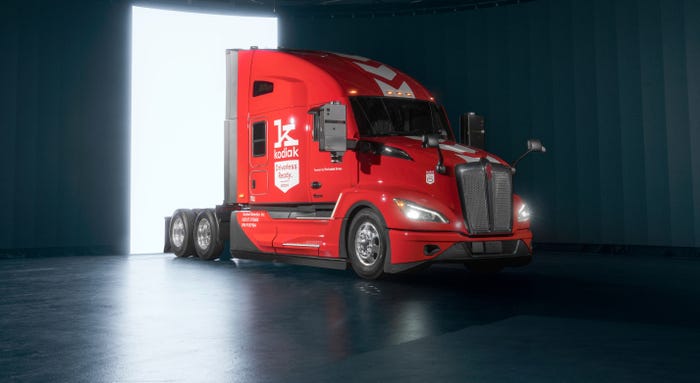Kodiak Reveals Landmark Self-Driving Truck at CES 2024
Company says the sixth-generation vehicle is the world’s first driverless-ready semi ready for scaled deployment

Self-driving company Kodiak Robotics used CES to reveal the truck that will lead the company into its fully driverless future.
The Silicon Valley-based firm claims that the sixth-generation vehicle is the “world’s first driverless-ready semi ready for scaled deployment,” and comes equipped with all the necessary redundant safety-critical hardware, as well as relevant software, to facilitate regular use without a human on board.
The unveiling represents a key breakthrough for Kodiak, whose CEO and co-founder Don Burnette told IoT World Today late last year that a redundant platform was the “missing piece” in the company’s plans.
Its arrival will allow Kodiak to initiate driverless operations on its existing freight route between Dallas and Houston in Texas later this year. Currently, autonomous trucks operate on the route, but with human safety operators.
The new truck includes redundancy across all safety-critical functions, including a redundant braking system and redundant steering, redundant power and Kodiak’s custom-designed Actuation Control Engine (ACE) system.

It also features twice the GPU processor cores, 1.6 times the processing speed, three times more memory, and 2.75 greater bandwidth to run software processes compared to Kodiak’s first-generation autonomous truck, which made its debut in 2019.
In the subsequent five years of real-world testing, more than 5,000 loads have been carried over more than 2.5 million miles, with Kodiak regularly updating its truck to reach the stage where it is considered “feature complete” across its hardware and software.
Among the key updates on the latest iteration are enhanced SensorPods, which now feature two upgraded higher-resolution automotive-grade lidar sensors, plus two additional side radar sensors to improve long-range object detection.
This brings the sensor count to 12 cameras, four Lidars and six radars, with the data processed by Nvidia GPUs.
The top-mounted SensorPods also feature extra bright hazard lights that will be used to alert other road users of the truck’s presence on a roadway, should it break down. Meanwhile, new microphones can detect and identify emergency vehicles and other irregular sounds that may represent a hazard.
The truck also includes redundant LTE communications links, allowing it to remain in touch with command centers in Lancaster, Texas, and Mountain View, California.
And later this year, it will also integrate Ambarella’s CV3 AI domain control System-on-Chip, following a recently announced deal between the companies.
“This truck fundamentally demonstrates that we’ve done the work necessary to safely handle driverless operations,” Burnette said. “While we continue to work with leading truck manufacturers, the technology we developed is deployment-ready, uncoupled from OEM timelines and truck manufacturer-agnostic, which allows us to move fast while keeping safety at the forefront.”
Over the past couple of years, the company has established itself as a leading figure in the growing autonomous freight arena in America’s southern states, via several pilots with major carriers.
Read more about:
CES 2024About the Author
You May Also Like








